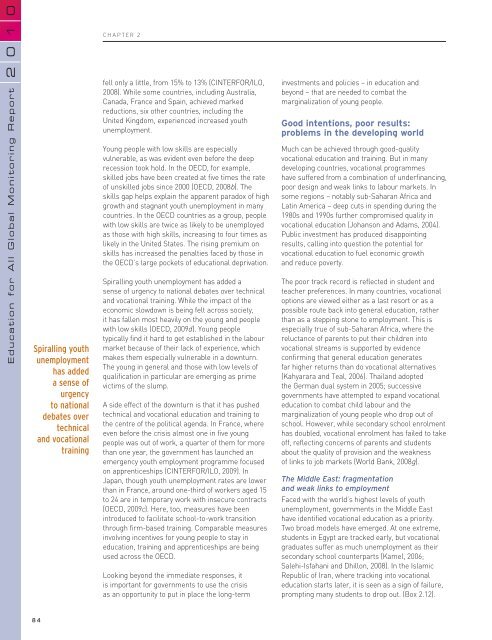Chapter 2. Progress towards the EFA goals - Unesco
Chapter 2. Progress towards the EFA goals - Unesco
Chapter 2. Progress towards the EFA goals - Unesco
You also want an ePaper? Increase the reach of your titles
YUMPU automatically turns print PDFs into web optimized ePapers that Google loves.
0<br />
1<br />
2<br />
0<br />
CHAPTER 2<br />
Education for All Global Monitoring Report<br />
Spiralling youth<br />
unemployment<br />
has added<br />
a sense of<br />
urgency<br />
to national<br />
debates over<br />
technical<br />
and vocational<br />
training<br />
fell only a little, from 15% to 13% (CINTERFOR/ILO,<br />
2008). While some countries, including Australia,<br />
Canada, France and Spain, achieved marked<br />
reductions, six o<strong>the</strong>r countries, including <strong>the</strong><br />
United Kingdom, experienced increased youth<br />
unemployment.<br />
Young people with low skills are especially<br />
vulnerable, as was evident even before <strong>the</strong> deep<br />
recession took hold. In <strong>the</strong> OECD, for example,<br />
skilled jobs have been created at five times <strong>the</strong> rate<br />
of unskilled jobs since 2000 (OECD, 2008b). The<br />
skills gap helps explain <strong>the</strong> apparent paradox of high<br />
growth and stagnant youth unemployment in many<br />
countries. In <strong>the</strong> OECD countries as a group, people<br />
with low skills are twice as likely to be unemployed<br />
as those with high skills, increasing to four times as<br />
likely in <strong>the</strong> United States. The rising premium on<br />
skills has increased <strong>the</strong> penalties faced by those in<br />
<strong>the</strong> OECD’s large pockets of educational deprivation.<br />
Spiralling youth unemployment has added a<br />
sense of urgency to national debates over technical<br />
and vocational training. While <strong>the</strong> impact of <strong>the</strong><br />
economic slowdown is being felt across society,<br />
it has fallen most heavily on <strong>the</strong> young and people<br />
with low skills (OECD, 2009d). Young people<br />
typically find it hard to get established in <strong>the</strong> labour<br />
market because of <strong>the</strong>ir lack of experience, which<br />
makes <strong>the</strong>m especially vulnerable in a downturn.<br />
The young in general and those with low levels of<br />
qualification in particular are emerging as prime<br />
victims of <strong>the</strong> slump.<br />
A side effect of <strong>the</strong> downturn is that it has pushed<br />
technical and vocational education and training to<br />
<strong>the</strong> centre of <strong>the</strong> political agenda. In France, where<br />
even before <strong>the</strong> crisis almost one in five young<br />
people was out of work, a quarter of <strong>the</strong>m for more<br />
than one year, <strong>the</strong> government has launched an<br />
emergency youth employment programme focused<br />
on apprenticeships (CINTERFOR/ILO, 2009). In<br />
Japan, though youth unemployment rates are lower<br />
than in France, around one-third of workers aged 15<br />
to 24 are in temporary work with insecure contracts<br />
(OECD, 2009c). Here, too, measures have been<br />
introduced to facilitate school-to-work transition<br />
through firm-based training. Comparable measures<br />
involving incentives for young people to stay in<br />
education, training and apprenticeships are being<br />
used across <strong>the</strong> OECD.<br />
Looking beyond <strong>the</strong> immediate responses, it<br />
is important for governments to use <strong>the</strong> crisis<br />
as an opportunity to put in place <strong>the</strong> long-term<br />
investments and policies – in education and<br />
beyond – that are needed to combat <strong>the</strong><br />
marginalization of young people.<br />
Good intentions, poor results:<br />
problems in <strong>the</strong> developing world<br />
Much can be achieved through good-quality<br />
vocational education and training. But in many<br />
developing countries, vocational programmes<br />
have suffered from a combination of underfinancing,<br />
poor design and weak links to labour markets. In<br />
some regions – notably sub-Saharan Africa and<br />
Latin America – deep cuts in spending during <strong>the</strong><br />
1980s and 1990s fur<strong>the</strong>r compromised quality in<br />
vocational education (Johanson and Adams, 2004).<br />
Public investment has produced disappointing<br />
results, calling into question <strong>the</strong> potential for<br />
vocational education to fuel economic growth<br />
and reduce poverty.<br />
The poor track record is reflected in student and<br />
teacher preferences. In many countries, vocational<br />
options are viewed ei<strong>the</strong>r as a last resort or as a<br />
possible route back into general education, ra<strong>the</strong>r<br />
than as a stepping stone to employment. This is<br />
especially true of sub-Saharan Africa, where <strong>the</strong><br />
reluctance of parents to put <strong>the</strong>ir children into<br />
vocational streams is supported by evidence<br />
confirming that general education generates<br />
far higher returns than do vocational alternatives<br />
(Kahyarara and Teal, 2006). Thailand adopted<br />
<strong>the</strong> German dual system in 2005; successive<br />
governments have attempted to expand vocational<br />
education to combat child labour and <strong>the</strong><br />
marginalization of young people who drop out of<br />
school. However, while secondary school enrolment<br />
has doubled, vocational enrolment has failed to take<br />
off, reflecting concerns of parents and students<br />
about <strong>the</strong> quality of provision and <strong>the</strong> weakness<br />
of links to job markets (World Bank, 2008g).<br />
The Middle East: fragmentation<br />
and weak links to employment<br />
Faced with <strong>the</strong> world’s highest levels of youth<br />
unemployment, governments in <strong>the</strong> Middle East<br />
have identified vocational education as a priority.<br />
Two broad models have emerged. At one extreme,<br />
students in Egypt are tracked early, but vocational<br />
graduates suffer as much unemployment as <strong>the</strong>ir<br />
secondary school counterparts (Kamel, 2006;<br />
Salehi-Isfahani and Dhillon, 2008). In <strong>the</strong> Islamic<br />
Republic of Iran, where tracking into vocational<br />
education starts later, it is seen as a sign of failure,<br />
prompting many students to drop out. (Box <strong>2.</strong>12).<br />
84
















